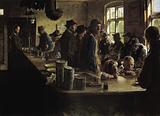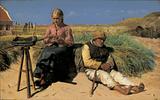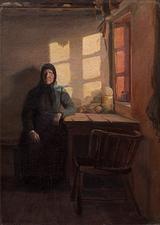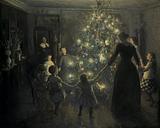The Skagen Painters
A Scandinavian artists’ colony in Skagen
.jpg)
P.S. Krøyer: 'At the victualler's when there is no fishing', 1882.
In the 1870s a wide range of Scandinavian artists and writers gathered in Skagen to take in and depict the natural scenery, the light and the locals of the fishing community. Decades before, artists such as the Golden Age painters Martinus Rørbye and Vilhelm Melbye and the writer Steen Steensen Blicher had already visited the town, but not until the last half of the nineteenth century did an actual artists’ colony form. The colony comprised Danish painters such as Anna and Michael Ancher, P.S. Krøyer, Viggo Johansen, Carl Locher, Lauritz Tuxen, the Norwegian artist Christian Krogh, the Swedish painter Oscar Björck and the poet and painter Holger Drachmann.

A local Skagen girl, Tine, and a blind man, Kristian, sit on the hot sand in Michael Ancher’s 1880 painting. The holes in their clothes and Kristian’s filthy feet testify to the harsh living conditions of the impoverished local population.
The artists’ haunt: Brøndums Hus
The artists who travelled from Copenhagen to Skagen in the 1870s all met up in the childhood home of the artist Anna Ancher (née Brøndum), which was the only guesthouse in town. Brøndums Hotel became the main haunt of the many artists and writers flocking to the town around this time. The painters Michael Ancher and Karl Madsen first visited Skagen in 1874, where each proceeded to fall in love with a local Skagen girl. In 1880, Anna and Michael Ancher were married, and Karl Madsen and a fellow artist from Copenhagen, Viggo Johansen, married two cousins of Anna Ancher called Henriette and Martha. The homes of the Anchers, located first in the Brøndum family’s garden house and subsequently in a house on Markvej, would go on to become chief meeting places for the artists in town.

Anna Ancher was the only Skagen artist to have been born and raised in Skagen. She was particularly fond of painting interiors that explored the effects of light. Here, we see an interior of the home of a blind Skagen woman, painted in 1885.

This blind local woman appears several times in Anna Ancher’s paintings. In 1883 Ancher did this oil painting, which shows us a more close-up view of the woman. It is set in the same quiet corner of the house as the painting done two years later.
Fishermen and open-air studies
The artists in Skagen were keen on outdoor studies and would often sit among the dunes, drawing and painting sketches and studies for larger paintings that would then typically be finishes in their studios. Grains of sand found in the paint of some of P.S. Krøyer’s large-scale paintings suggest that some of the large canvases were painted out of doors too. But the artists were not just interested in the harsh countryside of Northern Jutland, in the sea, the light and the sunsets. The Skagen artists also created countless depictions of fishermen at work and of the penniless locals. On example is P.S. Krøyer’s At the victualler's when there is no fishing from 1882, which he painted in the year when he first arrived in town. With their depictions of fishermen and the poor, the Skagen artist placed themselves within the period and movement in Danish art and literature known as the Modern Breakthrough. The artists’ activities in Skagen received a more formalised stamp of recognition in 1908 when Skagens Museum was founded by Michael Ancher, P.S. Krøyer, Laurits Tuxen and others.
.jpg)
The local fishermen are taking a break from their work in the grocer’s shop, and a pipe-smoking fisherman catches the eye of the painter, P.S. Krøyer. The work dates from 1882, the year in which Krøyer first visited Skagen and began his lifelong relationship with the city.
.jpg)
The Skagen painter Viggo Johansen lived in Skagen with his family for stretches at a time, but here we get a look inside the family’s Copenhagen living room on Christmas Eve. The atmospheric painting 'Silent Night' is from 1891.